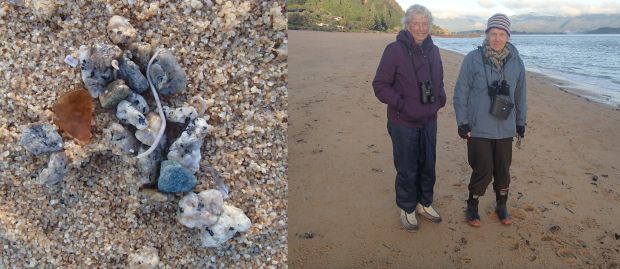
In mid-winter the spotted shags that gather at Tata Beach on most mornings are in full breeding plumage (image: A. Ballance)
Golden Bay is home to a wildlife spectacle that only a few early risers know about. Each day at dawn, especially in mid-winter, large numbers of spotted shags arrive at Tata Beach for a bit of bathing and stone swallowing and regurgitating. And for the last 4 years a group of locals, led by John Barraclough, has been counting and observing the shags to try and work out what’s going on. The highest number of birds they have counted on the beach in a single morning is 5000, and although spotted shag numbers declined significantly last year they now seem to be rebuilding.

The pile of regurgitated stones at left includes a piece of sea-worn glass and a parasitic nematode worm; there are piles of regurgitated stones on the beach at the feet of Rosemary Jorgenson (left) and Helen Kingston (images: A. Ballance)
With group members Helen Kingston and Rosemary Jorgenson from the Ornithological Society of New Zealand as her guides Alison Ballance managed to time a visit to the beach just hours after a big storm ended. The waves breaking on the beach failed to deter about 200 spotted shags that turned up and duly left piles of regurgitated stones on the beach.

Spotted shags have been regular dawn visitors to Tata Beach in Golden Bay for as long as anyone can remember. Smaller numbers also gather on some other local beaches, inclduing in nearby Abel Tasman National Park (image: A. Ballance)


